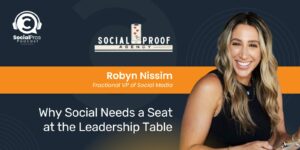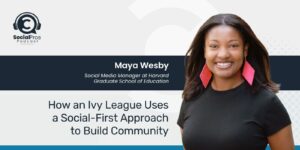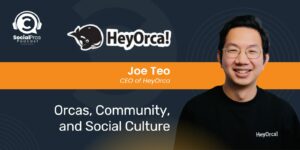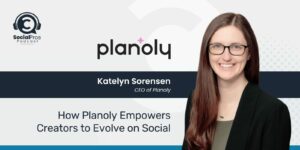Hosted By
About Social Pros Podcast:
Social Pros is one of the longest-running marketing podcasts in existence (10 YEARS and counting), and was recently recognized as the #1 Audio/Podcast Series by the Content Marketing Awards.
Our purpose? Making sure that we speak to real people doing real work in social media.
Listeners get inside stories and behind-the-scenes secrets about how teams at companies like Google, Reddit, Glossier, Zillow, Lyft, Marvel, and dozens more, staff, operate, and measure their social media programs. With 600+ episodes, the Social Pros Podcast brings the humanity of social media to the forefront, while providing incredibly useful marketing strategies that listeners can immediately implement.
Follow Social Pros on LinkedIn.
To inquire about becoming a guest or show sponsor, please email our Executive Producer, Leanna Pham, at leanna@convinceandconvert.com.
Apple Podcast Reviews:
The Social Pros podcast has quickly become a favorite in my feed! I'm consistently impressed by the engaging conversations, insightful content, and actionable ideas. I truly learn something every time I listen!
@Arlie KThis is absolutely an awesome listen for anyone in communications or social media!!
@Will31CThis podcast has become one of my staple weekly podcasts for learning about marketing! Love the conversations that they have and it's always enjoyable and educational!
@Simonstone95Love the podcast - informative, in depth and spot on for any business size.
@MissTriathlon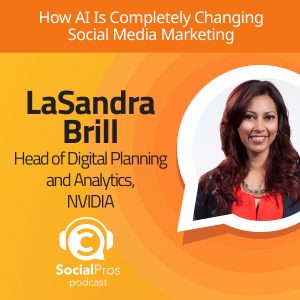
LaSandra Brill, Head of Digital Planning and Analytics at NVIDIA, joins the Social Pros Podcast to discuss how to manage the competing needs of a B2B/B2C company that has embraced the future of AI.
 The New Social Media
The New Social Media
The future of social marketing has arrived, and it’s not human.
It’s artificial intelligence, and it will help your business on every level; from closing sales to recruiting to metrics that work for your audience.
Whether it’s Facebook, Baidu, Tesla, BMW, data centers, anything that you see in all the headlines of the AI…there’s an excellent chance that NVIDIA has somehow been involved with it.
Starting out as a B2C company that designed graphics for hugely popular video games and consoles, NVIDIA has now forayed into the world of AI. The addition of a pioneering B2B field to a full plate has presented LaSandra with both opportunities and challenges when it comes to social media marketing.
Ultimately, she has discovered that the key to managing an innovative B2B/B2C company is about knowledge and separation. Knowing your audience and how they interact with you and your product is important to utilize social properly so that you can easily appeal to your base. Additionally, separating your social lines will keep customers engaged with the posts that matter most to them.
In This Episode
- How balancing B2B and B2C branches leads to a separation of powers
- Why integrating social customer care means understanding if it will work for your market and customers
- How a combination B2B/B2C marketplace leads to a flexible way of looking at KPI
- Why impactful use of sentiment analysis means a learning model that adapts to your specific audience
Quotes From This Episode
“I have to really partner closely with the consumer side to lend their expertise on how to approach an audience and what’s the right tone because it is such a unique audience.” —@LaSandraBrill
“We think LinkedIn is a really strong tool for recruiting. And recruiting for AI experts right now and deep learning is a really competitive space, so we’re really actively making sure that we have a presence there.” —@LaSandraBrill
“When it’s live action happening in the moment, whether it’d be through content or through video, I do think videos are becoming bigger and more of a preferred channel.” —@LaSandraBrill
There's still a few golden eggs out there when it comes to the old world organic social. Click To Tweet
“We are really trying to partner with companies who are using our technology as much as possible, and really trying to advance our marketing with the concept of AI and deep learning.” —@LaSandraBrill
Resources
- LaSandra Brill on Twitter: @LaSandraBrill
- NVIDIA on Twitter, Facebook, Blogs, and YouTube
- All NVIDIA Social Channels
- Searchmetrics
- Rocket Fuel
- Zignal Labs
- Adobe Sensei
See you next week!
Transcript
| Jay: | Welcome everybody to Social Pros, the podcast for real people doing real work in social media. I am, as always, Jay Baer from Convince and Convert, here on Episode 266 of Social Pros. Flying solo today, Adam is off doing the things that he does at Salesforce Marketing Cloud, but that’s okay because we have a blockbuster guest. I have been wanting to have this individual on Social Pros for essentially the entirety of this six year history of this show. We have finally put it together. I am delighted to welcome on the program LaSandra Brill, who is the Head of Digital Planning and Insights at Nvidia. LaSandra thanks so much for being on the show. |
| LaSandra: | Thanks for having me. |
| Jay: | Tell us a little bit about all the things that Nvidia does. I suspect that for many social pros listeners, they may know about one piece of the business or another piece of the business, but they may not understand the full magnitude of all the things that Nvidia are involved in, so can you set that up for them a little bit? |
| LaSandra: | Definitely. I think most people when they think about Nvidia, think of us as the gaming company, the GPUs that are used for PC gaming. And that is certainly where we have our roots, but those same gaming cards lo and behold, with the invention of the GPUs, have ignited the AI revolution, so we are starting to use them on the enterprise side of the business as well. We have this whole other side of the business besides consumers, but enterprises who are using our GPUs to fuel their AI programs, whether it’d be Facebook, Baidu, Tesla car, BMW, all of the autonomous vehicles, robotics embedded, data centers, anything that you see in all the headlines of the AI, there’s a very good chance that Nvidia is somehow involved with that. |
| Jay: | That’s gotta be super exciting. How do those enterprise organizations get at that? Do they work with you directly and say, “Use your awesome horsepower to do some serious AI work,” or they’re getting at your capabilities through a partner? |
| LaSandra: | We have some partners where they can access the GPUs that way. We also do sell supercomputer, or DGX, a number of packages for the drive PX and all of the different products that are on autonomous vehicle, so it really depends on which side of the industry they’re on and involved with, and how we would work with them. And we have solutions all the way down from start-ups that are getting started, that want to put AI … use one of our GPUs in their engines for deep learning, all the way up to a full more intelligent higher processing unit, do to something like an autonomous vehicle. |
| Jay: | It’s gotta be a real challenge for you on the digital side. Probably anybody there, in marketing or communications, because you have a very core consumer business, and now this giant enterprise B2B play as well, all under the same umbrella. That’s almost like running two totally separate companies that just happen to share a logo. Talk about that a little bit. |
| LaSandra: | Exactly. It’s very head spinning at times. I go from one meeting and we’re talking about Overwatch and World of Warcraft, and then I’m in another meeting and we’re talking about autonomous vehicles and robotics. And it’s just like two totally different topics and totally different audiences. One of the challenges that we had recently, is we had to take all of our social channels and rebrand them, so that we have a dedicated home for that enterprise audience and a dedicated home for the consumer audience, because it was initially all of the Nvidia channels were just consumer audience, but as we start building up this enterprise business and building connections on the enterprise side of the house, it just didn’t make sense. So we’ve just recently split up and rebrand it, and we have a whole set of channels that we are building now on the enterprise side of the house. And then we’re using our GForce brand for the consumer side to help differentiate between the two. |
| Jay: | Do you- |
| LaSandra: | But if you follow our corporate handle, it will certainly … sometimes it’s like one minute it’s talking about gaming, the next minute we’re talking about let’s get drones. |
| Jay: | What is going on here? |
| LaSandra: | Exactly. |
| Jay: | I mean, I don’t understand what’s happening. Do you then have your teams set up, so you’ve got people on the digital team who are really devoted to B2C and some they’re devoted to B2B? Or is everybody doing it all? |
| LaSandra: | My team is what we call Essentialized DMO Organization, digital marketing organization, and we support both sides of the business. Now, there are business stakeholders of course within the business units on both consumer and enterprise, where we’re partnering with them to build and execute a program, and they manage the dedicated channels, like Nvidia AI’s example on the enterprise side, and then Nvidia GeForce … |
| Jay: | Sure. |
| LaSandra: | … on the consumer side. They’ll manage those channels, we manage the corporate channels. So we’re working back and forth with all of them. I do have people that are just supporting both sides of the business, and then in some cases on the paid media side, I do have somebody who’s more dedicated to the consumer side and one somebody on the enterprise side. |
| Jay: | Are you doing the social customer care as well, or is that handled at the individual unit level? |
| LaSandra: | We don’t have a big social customer care in place here at Nvidia yet, and it’s really a resourcing issue. It’s on the radar, but it’s not something that we actively do today. |
| Jay: | I mean, I wouldn’t think you’d have a ton on the enterprise side, but I would think that some of the gamers would be like, “Hey, what about this, what about that?” |
| LaSandra: | Yes. We tackle that in different ways and we really just go directly to customer support, but not really a social customer support. |
| Jay: | Yes. |
| LaSandra: | There’s a lot of trolling that happens in the gaming community … |
| Jay: | In the gaming world, no kidding. |
| LaSandra: | Exactly. So we have to really be extra careful on how we engage and what we engage, so we’ve kind of shied away from that in the past. |
| Jay: | Yes. As the gaming world and the entire eGaming thing is so much bigger than a lot of people recognize, you’ve got all kinds of live streaming with Twitch and everything else, then you’ve got now college teams and big global competitions. Does Nvidia sponsor some of those things? Are you out there saying, “Hey, we’re going to sponsor this team,” or, “We’re going to have athletes that represent our products.” Are you getting into that level of consumer marketing? |
| LaSandra: | Yes. We have sponsored some teams in the past and we’ve worked with some teams in the past. We’re not actively sponsoring a team right now, but eSports in particular is definitely growing in popularity. I believe that more people are now watching eSports than NFL. It’s definitely no joke and it’s growing bigger every day. We do have a good representation there though, pretty much all the winning teams are using our equipment, which is great, so there’s definitely … |
| Jay: | Yes. |
| LaSandra: | … some strong brand affiliation with the quality of the products that we have. |
| Jay: | Your history in social and in digital is on the B2B tech side. You’ve been in the Bay area for a long time and been at Cisco and other places. When you got to Nvidia and got your nose into this whole eGaming, crazy millions of people doing competitive gaming, were you just like, “What is going on here?” Was it quite an eye opener for you? |
| LaSandra: | It is. I’m not a gamer, so I’m in these meetings, and I’m definitely … |
| Jay: | I was going to ask you about that. Do you guys sit in the conference room and play games? Is that part of the deal? Do you have to try everything? |
| LaSandra: | We did go on an off site to the Gaming Lounge in downtown Saint Jose and that was fun. |
| Jay: | Yes. |
| LaSandra: | That was my first time playing Overwatch. |
| Jay: | Yes. |
| LaSandra: | I play games, but not traditional PC games, which is what we’re known for. |
| Jay: | Yes. |
| LaSandra: | I was excited, when we … we have our product in the Nintendo Switch now and I’m like, “Okay, that’s something I can get and play.” |
| Jay: | Now you got it, yes. That’s funny. That Switch is amazing. |
| LaSandra: | Yes. I’m like, “That’s more my style.” But we are in these meetings, I have to really partner closely with the consumer side in particular to really lend on their expertise on how to approach an audience and what’s the right tone, what’s the right approach, because it is such a unique audience. It’s a really … I’m still definitely learning a lot about that audience and what’s the best tactics that work with them. |
| Jay: | Yes, for sure it’s a subculture, no question. On the enterprise side, I know you do a lot of LinkedIn, as most people in B2B tech do. Is that from a paid perspective, or from a LinkedIn content publishing perspective, or both? |
| LaSandra: | We do actually quite a bit with LinkedIn. We leverage the LinkedIn Elevate product for social employee advocacy … |
| Jay: | Yes. |
| LaSandra: | … and amplification. We have a paid media program with them, so we’re running LinkedIn in mails occasionally, doing some promoted posts and then we … Our CEO posts his blog post on the LinkedIn profile, so really a LinkedIn influencer in posting content that way. And then we have some programs for the Sales Navigator, the LinkedIn navigator tool … |
| Jay: | Yes. |
| LaSandra: | … for the sales team. And then we’re doing a lot with managing and maintaining our LinkedIn updates. We think it’s a really strong tool for recruiting. And recruiting for AI experts right now and deep learning is a really competitive space, so we’re really actively making sure that we have a presence there and we know that that’s where people are going to go check us out for that audience in particular. |
| Jay: | Where’s your head at these days with Twitter? As I mentioned, you’ve been in this space for a long time, you’re one of the pioneers in big company social strategy and digital execution. When you and I got started in this business, Twitter was a lot different than Twitter is now in a multitude of ways. What do you think about Twitter today? |
| LaSandra: | I’m skeptical these days. I’m really watching them and curious to see how they’re going to handle some issues. I don’t know if you saw the news, there’s a lot of bots that are being counted there, so … |
| Jay: | Yes. |
| LaSandra: | … there’s some questions on the credibility and the validity of some of the audience reached that were seeing. The results are touch and go, so I think it’s easy to get the vanity results out of them. I think as you get deeper into actual KPIs, they’re not showing up as strong for us, so that makes me kind of wonder too, how much of that vanity metrics that we’re seeing potentially could be coming from bots and we’re thinking that it’s performing better than it was. I don’t know. I don’t want to say we’re pulling the plug, but we certainly have reduced some of the investments in that channel … |
| Jay: | Yes. |
| LaSandra: | … over the past few months. |
| Jay: | The whispers that they’ve been putting out there about becoming sort of a real time video network, sort of YouTube, minute to minute sort of cable news online if you will, I think that’s an interesting concept. That doesn’t really exists today and if anyone was going to do it, they would do it, but I just wonder if Twitter goes mostly video, does that save them … |
| LaSandra: | I think that’s a good thing … |
| Jay: | … or does that become a novelty? |
| LaSandra: | I think it’s a good position for them and I certainly think that where they shine is news. When it’s super timely, that’s where they shine. We have our big JTC conference for example coming up next week. You want to bet we’re going to be doing some live Tweeting and that’s a core part of that strategy. When it’s live action happening in the moment, whether it’d be through content or through video, I do think videos are becoming bigger and bigger and more of a preferred channel, so I think it’s a good move for them. |
| Jay: | There’s also a bit of big shift of course in social since you got started from organic to paid. The paid media is one of your responsibilities in your role. Back in the day there wasn’t a lot of paid social, because A: there wasn’t a lot of paid social opportunities, and B: you could generate a lot of attention just with organic publishing. As we all know, those days have ended for the most part. How do you feel about that and what do you think about, in terms of social and paid, is it one and the same, is paid just an amplification for organic? Where’s your head at these days? |
| LaSandra: | It’s one and the same and it’s merged for me and my career, for the last four years now. When I joined Symantec … I was at Symantec before Nvidia, I was there for three years … my role was paid media and social media, and that included paid social, as well as the broader definition of paid media, so anything from billboards on the one on one, to all of the display ads and programmatic. We think of that the same way here at Nvidia. I manage our paid media strategy, including paid social. I think those, for us, are one and the same and for me it’s been one and the same for a while. I do think that there’s still a few golden eggs out there when it comes to the old world organic social, that can result in some good tangible metrics. I think that Core is a little bit of a golden egg, a golden gem that people don’t often know about … |
| Jay: | Yes, sure. |
| LaSandra: | … or really leverage. They have such a great network of publishers that they work with, so the ability to post something organically as a question and get it syndicated on a number of news site and get that earned media is really great. That’s one of the big ones that we’re seeing as an opportunity to earn media at no cost, really just- |
| Jay: | Yes, that’s a good tip. We should get somebody from Core on the show to talk about the ins and outs of that. That’s a really good tip, I love that. You mentioned KPIs a moment ago. What are you really looking at? I suspect … and I could be wrong, please tell me if this is entirely incorrect … but I suspect that from a social perspective, you’re not doing a lot of direct selling. People aren’t consuming a LinkedIn post, paid or organic, and saying, “Get me some of that Nvidia. Here’s my credit card, or here is my purchase order.” How are you modeling the relationship between what’s happening in social and revenue at the end of the snake? |
| LaSandra: | Well this is, again, where we have different business models, because in some cases we are actually going straight to a buy page. On the consumer side, people can go directly on our website and you can buy a shield for $200. It’s not unreasonable … |
| Jay: | Yes, good point, yes. Sure. |
| LaSandra: | … to put an offer out there and expect them to click and just buy. It’s not like it’s a big purchase. It really depends on what we’re promoting. In some cases the KPI is how many units are we selling? We’re also looking at how are we shortening this time to upgrade. And are we upselling them from one card to the next, so that we can get them to that next bracket. That’s kind of the mentality on the consumer side. On the enterprise side, certainly it’s a longer sell cycle, it’s a more complex sale cycle, where you’re working with often multiple buyers, so you’re building relationship at the account level not a person level, or multiple people at that account. In that case, the KPIs are often how many contact acquisitions are we getting, net new names, how many net new names, or how many names or contacts form an account, so we can start getting an idea of how an engaged an account person is versus just a person. |
| Jay: | I want to ask you just a second about all the work that you’re doing with artificial intelligence in your marketing. You’re actually using the technology and the tactics and the horsepower that you have at your disposal in your own marketing. I want to ask you about that in just a second. First, I want to take just a moment to thank this week’s sponsor of the big Social Pros podcast, the number one podcast for big brand social media professionals for now six years. The show is brought to you by Salesforce Marketing Cloud. As we were just talking about with LaSandra Brill from Nvidia, social is manifestly a paid circumstance now, and you need to know what are solid target click-through rates, conversion rates, etc. And our friends at Salesforce Marketing Cloud put together a publication that helps you understand just that. It’s called The Future of Ads. You can get it at bitly/salesforceads. That’s bitly/salesforceads. All kinds of information about target click-through rates, conversion rates for Facebook ads, Twitter ads, Google ads and more. Download it today, you’re going to love it. The show this week is also brought to you by our friends at Yext, Y-E-X-T, the leaders in knowledge management online. Did you know that consumers trust information from other consumers as much as they trust their friends and family members, typically, in the form of ratings and reviews? Ratings and reviews are more important than ever, trying to make buying decisions that are smart. Myself and Daniel Lemin, one of our strategists at Convince and Convert worked with Yext on a little white paper called How to Win Digital and Real World Traffic With Local Reviews. You can get that at offers.yext.com/reviews. That’s offers.yext.com/reviews. LaSandra, as we talked about a minute ago when we kicked of the show, you are now on the enterprise side working with lots of brands in a ton of different industries to allow them to plug into AI machine learning, etc, to improve their own insights and their own businesses. You’re using those same kind of tools and technologies to improve your own marketing. I’d love for you to talk about that a little bit, because it’s just absolutely fascinating to me. |
| LaSandra: | Yes. We are really trying to partner with companies who are using our technology as much as possible, and really trying to advance our marketing with the concept of AI and deep learning. Anywhere from our programmatic, we have a number of ads being ran through Rocket Fuel, where they’re using AI engine to dynamically determine who’s the right person to target, based off of a pattern that they’re seeing and how that … so really optimizing to the actual KPI. For us if it’s a conversion, optimizing to that instead of just the click, and it’s doing that dynamically based off behaviors and patterns. We use Searchmetrics, which allows you to deconstruct the Google rank … the new engine that they put on with the AI, and it basically allows you to, in real time, enter your content, and it’s just going to show you how it’s going to rank and how Google is going to classify that content based on how it’s written. Zignal Labs is our social listening tool. They’re using deep learning, anywhere from image identification and tagging, to anomaly detection. |
| Jay: | I love those guys. Terrific product. |
| LaSandra: | Yes. |
| Jay: | They’re a former sponsor of the show, here on Social Pros. Our pals at Zignal Labs, check them out. Zignal, Z-I-G-N-A-L Labs.com |
| LaSandra: | And then the sentiment analysis too that they’re using. It’s a learning system, it’s really looking at how you were training the system for your brand, which is really helpful for us, as we talked about earlier, with the gaming audience being so unique, so we can really start training … |
| Jay: | Sarcastic. |
| LaSandra: | Yes. So it really needs a lot of training and understanding of that subculture, to get a more accurate result. We’ve been spending a lot of time with them on helping to perfect that. |
| Jay: | Gosh, I didn’t even thought of that, but that is so true, that if we just used a regular sentiment scoring module and then you apply that to a gaming community … |
| LaSandra: | They’ll be so confused. |
| Jay: | … you can really … it would be so messed up. Yes, that’s really fascinating. The company specific sentiment analysis that’s self learning. That’s really, really smart. |
| LaSandra: | Yes. And then Adobe. We’ve really gone all in with the Adobe. Adobe Sensei is using a lot of the Nvidia products to incorporate AI into how they’re approaching things. Really it’s in everything. I really think that the concept of AI is almost like the concept of social media seven, 10 years ago, where it’s new, and it affects and changes everything in how we communicate and how we market. Not just marketing, but HR. We have products in here that HR is using it to review a job description and determine how it’s going to perform with a particular audience. A male versus female, as we’re trying to target more female engineers. I mean, it really touches- |
| Jay: | Does that just freak you out? Does that just totally freak you out though? Because- |
| LaSandra: | I guess not me. I get excited. I’m like it’s new, it’s cool- |
| Jay: | You’re excited too, that’s why I love you, because you’re a genuine nerd. I love it. |
| LaSandra: | Yes, exactly. |
| Jay: | But okay, let’s think about this. When you started doing this, when you started in business and in marketing, it was be a good writer, be a good story teller, be a good communicator and if you’re really a pro, be a good analyst. And now, I’ve got a daughter going to marketing school in September and it’s like, “Oh yes, and by the way, you need to be an artificial intelligence expert as well.” It’s like what? What? |
| LaSandra: | Yes. |
| Jay: | The rules have changed. |
| LaSandra: | I have data scientists on my team for the first time here at Nvidia … |
| Jay: | Yes. |
| LaSandra: | … and I’m like, these guys are way smarter than I am first of all, and I’m in this … they’re teaching me about neural networks and regression, random forest, all these different models that we can use to better understand our audience, and to better target, and it really takes … We’ve been talking for years I feel about marketing is about the right content and the right message at the right time. The right person, the right message, the right time, right? But the reality is, AI is what’s going to actually make that happen. |
| Jay: | Make it possible. Absolutely. |
| LaSandra: | It’s going to make that possible. Now, it’s exciting that we’ve been trying to do that as best as we could before, but now it’s talking it to a whole other level, and it needs to be applied in everything that we do to execute. We’re bringing all the teams together … |
| Jay: | Yes. |
| LaSandra: | … and we’re learning this as we go. And I say we’re paving the pathway as we walk on it. |
| Jay: | Yes. It’s an exciting time, there’s no question. And you touched on something really important, this notion of getting different skills and different talent on your marketing team. I hosted a CMO Summit for Oracle last week at their big conference, and I asked 150 CMOs what’s the number one challenge for you right now, and it was exactly that. It was getting the right kind of people on our marketing team, given where marketing is today and where it’s headed, right? Because as you mentioned earlier, data scientists don’t grow in trees, right? |
| LaSandra: | Yes. |
| Jay: | It’s not like there’s a surplus of people who understand this right now, so there’s going to be a real talent issue in marketing starting today, and I think a lot of people don’t see it coming yet. |
| LaSandra: | Programmatic is another one. That’s … |
| Jay: | Yes. |
| LaSandra: | … I think a numerous skill set too that we’ve been having on a team. In the past, when I was at Symantec, we outsourced that with an agency, but here we’re building that talent in house. We’re figuring it out as we go. The folks on the team didn’t necessarily have experience, but they’re learning it and we’re figuring it out and we’re doing pretty well. I’m pretty happy with the results the teams has been delivering on. |
| Jay: | How did you get into this originally? So why did you decide to go into this kind of work, in the B2B marketing. How did that happen for you? |
| LaSandra: | Now you’re bringing it back. I think it was a little bit on accident. I was actually started off in college as far as pre-med, and I was working in a hospital, but I was doing marketing. And I realized at the time that I didn’t really want to be a doctor anymore, because I didn’t want to work holidays and weekends and people get sick all the time. |
| Jay: | You would’ve been a great doctor. |
| LaSandra: | So I was like, “This isn’t really for me.” And I was doing marketing at the time, and I was like, “You know, I kinda like what I’m doing and I feel like I can continue doing this.” So I stayed in, and I decided to switch to business and then I was like, “Okay, now that I’m doing this …” I’m like, “If I’m going to do marketing, I don’t know if health care marketing is where it’s at.” So that’s when I switched to tech. And my first tech job, it was a long time ago, back at Fat Brain, which was an online bookstore that got bought by Barnes and Noble over the years. But that’s how the two started coming together, marketing and business. |
| Jay: | Fat Brain, that is a blast from the past. |
| LaSandra: | Yes. |
| Jay: | Man, that is some old school right there. |
| LaSandra: | I’m aging myself here. |
| Jay: | You mentioned to me before we started the show, that you just finished writing a children’s book, which is so awesome. So A: tell us about the children’s book, B: how did you possibly find time a children’s book? |
| LaSandra: | I know. I have a daughter with Down syndrome, it’s my littlest. I am a mother of three, but my littlest one, she’s two and a half, she has Down’s and she’s going to be starting pre-school pretty soon. And one of the things that I’ve found, is that people are never really sure, and it’s sometimes hard to tell if she has Down syndrome or not, but you’re kind of looking at her and something’s a little different. And I felt like a wanted to open that door. I didn’t want people talking to other parents, “Is that kid … is something wrong with her? Or what going on, is she a special needs, does she has Down’s? I don’t know.” I really wanted to open that door up and have the parents feel comfortable talking to me about it. I wrote a children’s book, and it’s a rhyming book that’s 12 pages, really short and simple. And it just opens the door of … very lightly, age appropriate, that’s for kindergarten and pre-K to second grade is the audience … of, “Hey, let’s just friends. Yes, I may be a little bit different, but just like you I just want to be friends. And I can learn things, but it may take me a little longer.” And I’m working with … actually my nanny who is an artist, is illustrating the book right now, and I’m going to be printing it in time to hand to these kids when she starts her first day of pre-school in the fall. |
| Jay: | Wow. That is so fantastic. What a great story. Congratulations. That’s really amazing. And it’s awesome to have a nanny who’s an artist. That’s a good play. That was well thought through. |
| LaSandra: | Yes. |
| Jay: | Is that how you screen for nannies? You had to made them do water colors in order to apply? Yes, it’s good. |
| LaSandra: | Exactly. What are your arts skills, how else can I leverage you? |
| Jay: | Did you use artificial intelligence and machine learning to find the perfect, artistic nanny? |
| LaSandra: | No, but that would be a really good use cased. |
| Jay: | You could now. Right, you could now. Yes, now … |
| LaSandra: | Exactly. |
| Jay: | … it’s all possible. It’s all possible in the future. I want to ask you the two questions that we have asked every single guest here on the Social Pros podcast. This is episode 266. What one tip would you give somebody who’s looking to become a social pro? |
| LaSandra: | I think right now … I mean, it’s the theme of the show right now, but it’s AI. I feel like AI, especially for folks who are up and coming and trying to figure out how they stand out at their companies and in their career, I think AI is where social was 10 years ago and this is the next big thing. So if you jump on that bandwagon early, learn it, understand it, you can become a pro very quickly, because it’s also new, so it’s just you getting that early edge, and you start educating the people around you and you start becoming that expert and taking your marketing team and your group to that next chapter. |
| Jay: | Now that is fantastic advice. I could not agree more. And the final question for you LaSandra Brill who’s the Head of Digital Planning and Insights at Nvidia, if you could do a Skype call with any living person, who would it be and why? |
| LaSandra: | You know Jay, I’m going to have to say you. I’m going to make … |
| Jay: | No, no … |
| LaSandra: | … I’m going to make you do it with me after this. We’re always so busy, but I’d love to just pick your brain for an hour. One of my favourite books still … and this is a little bit dated, but it’s still 100% relevant, is the Youtility book. |
| Jay: | Thank you. |
| LaSandra: | And so many people with the content and making it useful … I still think it’s a challenge that my content producers face. They want to just fall into the same old content every time and rather than thinking about how it’s going to be used and how it’s going to be used along the buyer’s journey. It’s been a while since we’ve chatted about that. I’d love to pick your brain again and figure out how we could bring some of those best practices back into the enterprise here at Nvidia. |
| Jay: | That will do it. That you, that’s very kind of you, I appreciate that. And it’s true though, it’s hard. Look, when you set out to create content that is so useful people actually want to receive it, that requires courage, because it’s not necessarily a direct path to revenue … |
| LaSandra: | Yes. |
| Jay: | … and not everybody can get behind that, right? You have to trust. It’s all about trust, really. You have to trust that your customers will reward you eventually for that and sometimes that’s a little bit hard to gravitate toward, especially when people are under a lot of pressure to deliver results and KPIs and revenue. One of the things that Mark Hurd said last week at this Oracle conference, he’s the CEO of Oracle, he said, “Look, CEOs are under an enormous amount of pressure from boards to deliver top line revenue and consequently that pressure goes to the CMO, and consequently that pressure goes to the digital and social media team,” so it becomes all about, “Deliver now, get me clicks, get me sales, get me leads, get me all of these things,” and that thinking is the enemy of utility, right? That thinking is the … |
| LaSandra: | Yes. |
| Jay: | … enemy of let’s just give the costumer something awesome and eventually they’re going to reward us. We’re at a weird time, where that concept of being useful with your marketing has been out there long enough that people, I think, generally speaking, understand it and embrace it psychologically, but embracing it operationally is a different thing entirely. |
| LaSandra: | I couldn’t agree more. And that’s the challenge. I think that the companies who have embraced it are stand out companies, and they have higher MPS scores, I’m sure they have better sales. But you have to execute it and commit to it. |
| Jay: | Yes. And it’s a marathon for sure. It’s not a campaign, right? |
| LaSandra: | Right. |
| Jay: | You got to do it over the long haul. I got a new book I’m kicking around too, I want to talk to you about and see what you think. So we’ll do that on this special Skype call that we’re going to set up as well. |
| LaSandra: | Yes. I would love that. |
| Jay: | Thank you so much for being on the show. I can’t believe it’s taken this long to put it together. My fault. You were fantastic as expected. Loved, loved, loved having you on the show. Ladies and gentleman, make sure you follow LaSandra in social media and beyond. We’ll make sure to link it all up in the show notes. Take a look of the things that Nvidia are doing as well, so you can see what she and her team are making happen day to day. Thanks very much for being here. |
| LaSandra: | Thanks Jay. |
| Jay: | On behalf of my friend Adam Brown from Salesforce Marketing Cloud who is not with us today, but he’ll be back next week, I am as always Jay Baer from Convince and Convert. This, my friends, has been Social Pros. |
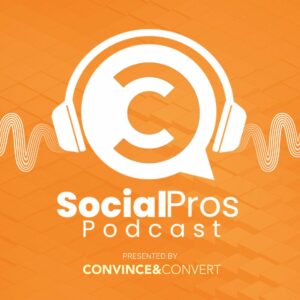


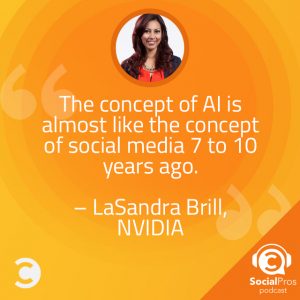 The New Social Media
The New Social Media
